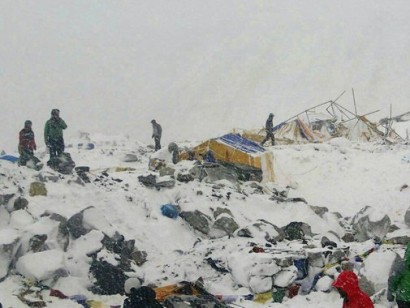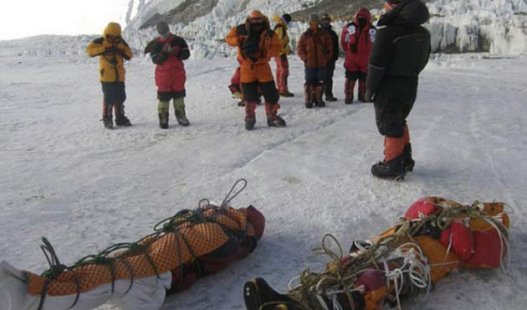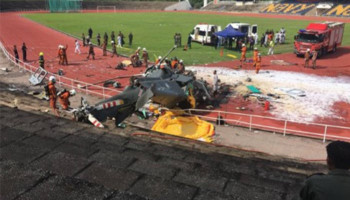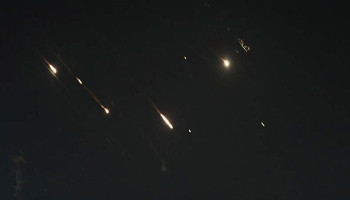Everest Climbers Are Killed as Nepal Quake Sets Off Avalanche
 A year after a deadly avalanche on Mount Everest ended the climbing season, multiple avalanches caused by the earthquake on Saturday rumbled down a treacherous icefall and slammed into the mountaineering base camp, killing at least 65 climbers and injuring at least 60 others, Nepalese officials said. Alex Gavan, a hiker at the base camp, described on Twitter a “huge earthquake then huge avalanche” that sent him “running for life from my tent.” Mr. Gavan warned that many of the wounded would die if they were not evacuated soon. Nima Namgyal Sherpa, a guide at the base camp, said the avalanche caused many injuries. Nepalese tourism officials feared hundreds of climbers may have died. “Many camps have been destroyed by the shake and wind from the avalanche,” Mr. Sherpa, the base camp manager for Asian Trekking, wrote in a post on Facebook. “All the doctors here are doing our best to treat and save lives.” Tempting death has always been part of the treacherous Everest experience, but these past two years have been particularly deadly. Last year, about 30 men were crossing a notorious area known by some local residents as the Golden Gate because of the shape of its ice formations when a huge chunk of ice cascaded down the mountain’s south side around 6:30 a.m. and engulfed them, killing 16. That avalanche, and the outrage among the Sherpas over their pay and safety conditions, forced the cancellation of the climbing season, a key part of Nepal’s tourism industry, and Tulasi Prasad Gautam, director general of the Nepal Tourism Department, said that “climbing Mount Everest may be canceled this year as well.” In last year’s accident, no foreign climbers were killed, partly because of the early hour. The climbers were Sherpas, members of an ethnic group known for their climbing acumen and who often use Sherpa as a surname. They are paid by foreign climbers to do the dangerous tasks of fixing ropes, carrying supplies and setting up camps. Continue reading the main storyEarthquake Causes Avalanche on Everest The earthquake that occurred near Katmandu, Nepal, touched off an avalanche on Mount Everest, causing injuries and deaths during prime climbing season. Saturday’s quake struck just before noon local time, making it likely that more people would have been climbing. One of those killed at the base camp was Dan Fredinburg, a Google engineer and avid climber who had sought to take the company’s Street View project to the world’s highest mountains. “Sadly, we lost one of our own,” Google said in a statement. Arjun Vajpai, a professional mountaineer, was on Makalu, a mountain in the Himalayas southeast of Everest, near the Nepal-China border, when the earthquake struck. “We’ve had a lot of disturbance here due to the earthquake,” he said in a video he posted to Facebook from his campsite. In the video, he points to a mountain visible behind him and says there have been a few avalanches in the area, as well as rockfalls. Most climbers on his team were fine, he said, but he had not yet heard from climbers who moved to other camps. Ang Sherpa, an experienced guide, said in an interview on Saturday that about 800 people were already staying at the Everest base camp, which is always a somewhat chaotic collection of tents, equipment and exhausted climbers and their attendants. A helicopter rescue operation to the base camp was planned for Sunday morning, he said, when a full tally of the dead and injured should become available. Mr. Fredinburg had worked at Google since 2007 and described himself as “Google Adventurer.” He worked on Google’s privacy team, recently advising on high-profile projects, including the self-driving car and Project Loon, an attempt to use stratospheric balloons to deliver high-speed Internet to rural areas and the developing world. He had led a number of expeditions to the Everest area, taking images for Google’s Street View project. “While there’s nothing quite like standing on the mountain,” he wrote in a blog post in 2013, “with Google Maps you can instantly transport yourself to the top of these peaks and enjoy the sights without all of the avalanches, rock slides, crevasses and dangers from altitude and weather that mountaineers face.” Tourism accounts for much of Nepal’s economy, with Everest one of the country’s biggest draws. And though money generated by people who climb the celebrated peak constitutes only a relatively small part of the country’s overall economy, it represents one of the few ways men can earn a living in Nepal. Foreign climbers pay professional tour companies and Western guides as much as $100,000 to climb, with assistance, the 29,000-foot (8,848 meters) peak. Sherpas are hired at about $125 per climb per legal load (set at 20 pounds) to ease paying climbers’ path up the mountain. The tour agencies pay several thousand dollars per climber to the Nepalese government for a climbing license, and those fees have brought the government $3 million to $4 million annually in recent years. There is also the money to the local economy for hotels, dining and cellphone rentals, as well as the hiring of local help to carry trekkers’ supplies. Ang Sherpa said he was certain that climbing would soon resume, but with the Katmandu airport shuttered after the earthquake and the entire country paralyzed, such a prediction might be premature. Though some climbers have little or no mountaineering experience, with good weather, dozens sometimes reach the summit in a single day. But limited oxygen and sudden changes in weather that can plunge climbers into blinding snowstorms and brutally cold conditions have claimed hundreds over the years, with the bodies of some of the dead remaining frozen in place for years. |


















